Case Study on Healthcare-Associated Infections
Introduction
The assessment below has two parts where one part presents a comparison and contrasting discussion about the two definitions given by the World Health Organization and Collins English Dictionary regarding different dimensions in relation to the health which includes mental, social, physical, intellectual, emotional, and environmental health). The second part of this assignment presents a case study of 59 years old woman named Carol suffering from diabetes and later diagnosed with MRSA. In the case study context, the study and explanation about the healthcare associated infections and their reasons to occur along with this how to control them is also given here.
Task 2: Explain different definitions of health
AC 1.1 Compare and contrast these two definitions:
a . “A state of complete physical, mental and social well-being and not merely the absence of disease or infirmity.” (World Health Organization, 1948).
b. “Health is a state in which a person is not suffering from any illness and is feeling well.” (Collins English Dictionary, 2018).

As stated by the World Health Organization, they meant a good health as a complete physical, social and mental state of the body of person and their well-being. It’s not just only absence of having any kind of disease in the body. While according to the Collins English Dictionary, a good health is only just not suffering from any illness and feeling just fine with the body. They don’t consider the mental, social and other dimensions as a part of good health. Although as per Kühn and Rieger (2017), the majority of the healthcare professionals have declared that just the presence of a normal no-disease body is not a sign of good health instead complete good health incudes all the dimensions of emotional, mental, environmental, social and most important the physical balance. The feeling of not having any ache or illness in the body doesn’t present a healthy person since if the person is suffering from any kind of mental stress or pressure or any kind of depression with a fine body then he/she cannot be considered as healthy. For those exploring this concept further, healthcare dissertation help can provide valuable insights and guidance.
A proper and complete healthy person must be able to enjoy and relish the highest and best possible attainable standards of healthy living. This is the basic fundamental right of every human being in the society with any kind of religion, race, economic or social condition ad political beliefs (sciencedirect.com, 2020). Both the definitions are far different from each other and presents different scenario of a healthy person. Although from both the definitions, the one declared by WHO will be best to consider after attaining all the arenas of a full and proper healthy body of a person.
Task 3: Carol Case Study
AC 3.1 Explain how and why the healthcare associated infection could have been acquired by Carol
Carol was initially taken to the hospital for the treatment of diabetes and she was suffering from severely infected ulcers in her legs. After admission during the treatment of those ulcers she was found positive for Methicillin Resistant Staphylococcus Aureus (MRSA). This disease of MRSA is an infection or infectious bacteria which are caused by the type of typical staph bacteria (nejm.org, 2018). This comes to those human bodies which are primarily resistant from various types of antibiotics which the healthcare professional use while treating the staph infections. There is possibility that Carol’s body also might be resistant to the kinds of antibiotics and this medical history was not known by the medical practitioner who was treating her and due to this negligence Carol was infected with Methicillin Resistant Staphylococcus Aureus (MRSA) (Gao et al. 2018).
Generally the hospital-acquired infections are usually generated because of the viral, fungal and bacterial pathogens which give rise to the most typical and common form of pneumonia or the Ventilator-Associated Pneumonia (VAP), Surgical Site Infection (SSI), Bloodstream Infection (BSI) and finally the Urinary Tract Infection (UTI) too (Dharmaratne et al. 2020). The hospital-acquired infections are mostly caused due to the significant illnesses and death. These kinds of infections have serious impacts on the emotional, medical and financial consequences also. It has been studied that at a time nearly about 1 to 25 patients gets infected with the hospital-acquired infections due to the hospital care (Lepak et al. 2021). There are mainly two types of hospital-acquired infections namely - Methicillin-resistant Staphylococcus Aureus (MRSA) & Central line-associated bloodstream infection (CLABSI). In this case where Carol got infected by the infection is Methicillin-resistant Staphylococcus Aureus (MRSA) which can be raised either due to the resistant to antibiotics or can be because of the hospital setups and instruments.
Here in the case of Carol getting infected, there is another possibility of this is contact of Carol with any person suffering form this infection because MRSA is a highly contagious infection and starts infecting people through direct contact with that person who is already having this infection in them. Carol already is suffering from ulcers in her legs which are a serious condition and the addition of this infection can be proved ore dangerous for her while she is having diabetes in her body since diabetes brings more types of infections to the body itself. The hospital-acquired infection of MRSA can be prevented if proper measures and protection have been used by the hospital care providers and professionals (Craft et al. 2019).
AC 4.1 Analyse the infection control measures that you would follow if you were the nurse in charge of the patients ward.
As the role of a nurse in-charge in any ward, the head nurse have her duty to maintain certain parameters of cleanliness and protections so that the existing patients and the working staffs don’t get infected with any kind of bacterial or fungal infection disease to them because if the care givers will get ill then there will be no one to take care of the hospitals and care settings and their patients also. So first of all they have to be fully safe and distant form any such kind of disease. There are a lot of prevention techniques and measure that can be taken or particularly I would have taken as a nurse in-charge to control the spread of infections in the patients’ ward and in other places can be like –
Take a deeper dive into Interrelation Between TB and Infections in Central Africa with our additional resources.
I would have first made sure that there are proper personal protective hygienic equipment such as masks, gloves, medical gowns and etc.) are present and if not then they must be brought as soon as possible to the care settings.
The next thing to look after is aseptic techniques for treating the patients like sterile drapes, gowns, sterile masks for both the patients and healthcare providers and sterile gloves and gowns and along with that hand hygiene too because dirty hands can cause a lot more new disease to people every minute.
Some other basic standard precautions which I would have taken are injection safety like new syringes and sanitised cotton tissues and other equipment and PPE kits for the care providers to keep themselves and the environment clean, protected and safe.
There are certain rules, etiquettes and practices that must be followed by all the care givers, patients and their family members if they visit the wards to see the patients such as coughing etiquettes which includes keeping the mouth covered with hands while coughing or sneezing in the wards or nearby patients. I would have prepared a list of some of these etiquettes and hang on the walls of the rad so that everybody must follow them strictly.
These are some of the control measure of the hospital-acquired infections which I would have followed or maintained if I were a nurse in-charge in any patients ward in a care setting.
Conclusion
This assessment mainly highlights that from both of the definitions of a good health; the one defined by the WHO is proper and appropriate in its meaning. World Health Organisation (WHO) declared that a proper and complete healthy person must be able to enjoy and relish the highest and best possible attainable standards of healthy living. This is the basic fundamental right of every human being in the society with any kind of religion, race, economic or social condition and political beliefs. And it can be concluded that in the case study of Carol, if proper measures and safety techniques were adopted then she would not have to suffer from MRSA.
Take a deeper dive into Case Study on Anorexia with our additional resources.
References
Craft, K.M., Nguyen, J.M., Berg, L.J. and Townsend, S.D., 2019. Methicillin-resistant Staphylococcus aureus (MRSA): antibiotic-resistance and the biofilm phenotype. MedChemComm, 10(8), pp.1231-1241.
Dharmaratne, P., Sapugahawatte, D.N., Wang, B., Chan, C.L., Lau, K.M., Lau, C., Fung, K.P., Ng, D.K. and Margaret, I.P., 2020. Contemporary approaches and future perspectives of antibacterial photodynamic therapy (aPDT) against methicillin-resistant Staphylococcus aureus (MRSA): A systematic review. European Journal of Medicinal Chemistry, p.112341.
Gao, C., Fan, Y.L., Zhao, F., Ren, Q.C., Wu, X., Chang, L. and Gao, F., 2018. Quinolone derivatives and their activities against methicillin-resistant Staphylococcus aureus (MRSA). European journal of medicinal chemistry, 157, pp.1081-1095.
Joshi, S.C., Diwan, V., Joshi, R., Sharma, M., Pathak, A., Shah, H., Tamhankar, A.J. and Stålsby Lundborg, C., 2018. “How can the patients remain safe, if we are not safe and protected from the infections”? a qualitative exploration among health-care workers about challenges of maintaining hospital cleanliness in a resource limited tertiary setting in rural India. International journal of environmental research and public health, 15(9), p.1942.
Kühn, S. and Rieger, U.M., 2017. Health is a state of complete physical, mental and social well-being and not merely absence of disease or infirmity. Surgery for Obesity and Related Diseases, 13(5), p.887.
Lepak, A.J., Shirley, D.K., Buys, A., Stevens, L. and Safdar, N., 2021. Implementation of infection control measures to prevent healthcare-associated transmission of severe acute respiratory coronavirus virus 2 (SARS-CoV-2). Infection Control & Hospital Epidemiology, 42(2), pp.229-232.
nejm.org, 2018. Changes in Prevalence of Health Care–Associated Infections in U.S. Hospitals, available at: https://www.nejm.org/doi/full/10.1056/NEJMoa1801550 [Accessed on: 5th January, 2021]
sciencedirect.com, 2020. What is good mental health? A scoping review, available at: https://www.sciencedirect.com/science/article/pii/S0924977X19318693 [Accessed on: 16th February, 2021]
Introduction
This assignment is classified into two different sections where one section describes an academic poster where there will be presented a comparison and contrasting description about the roles of an adult nurse of a care setting, a social worker related with the health care activities and a mental health nurse working in a mental healthcare setting. The differentiation will be done on the basis of their roles, responsibilities and skills that needed to be acquired by them. And adding to this the second section of this assessment will mainly focus on the explanation of health promotion and health education with their differences in approaches and will also evaluate the involvement of mass media in context with the health promotion in different care settings.
Task 2: Academic Poster
Create an academic poster that compares and contrasts the health education/promotion role of these three of the following health professionals in different settings
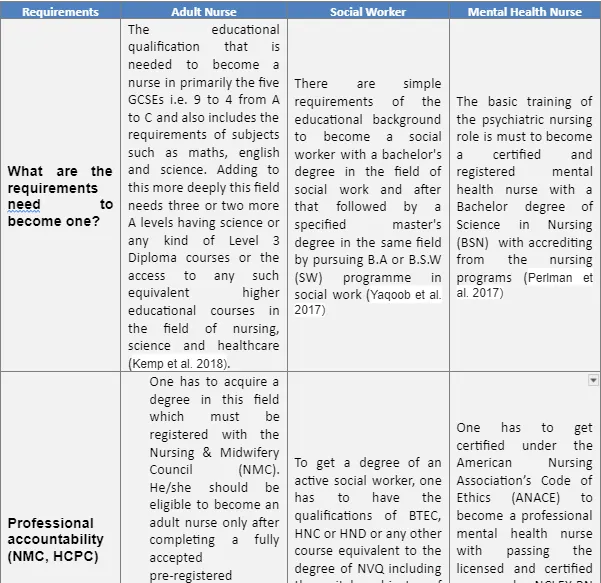

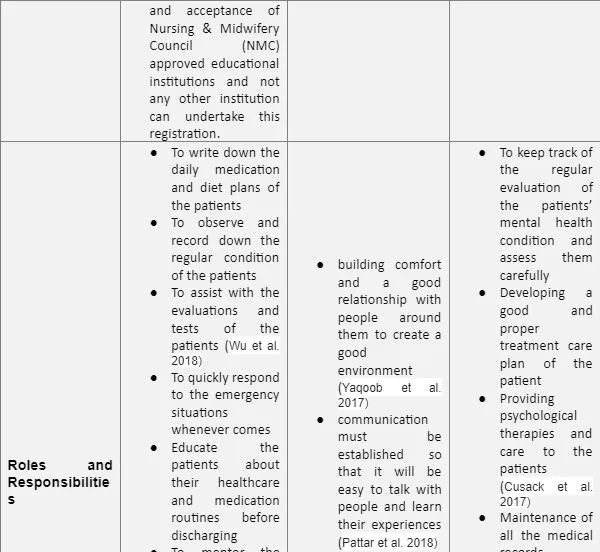
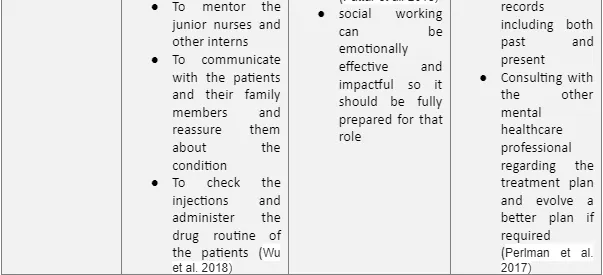
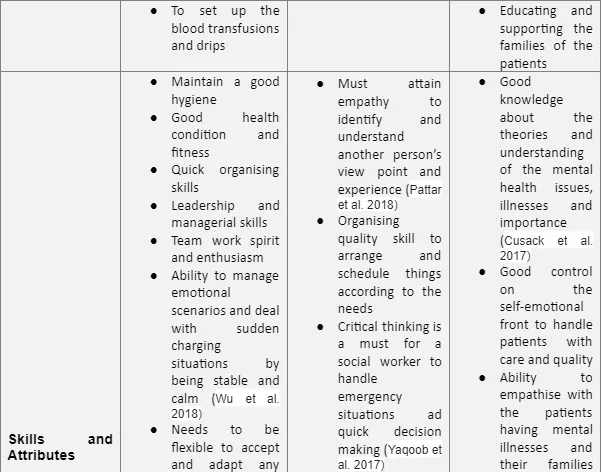
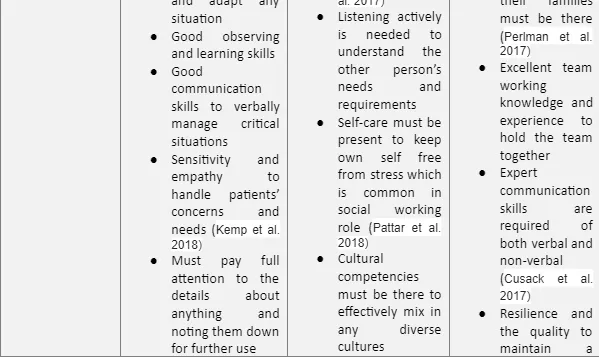
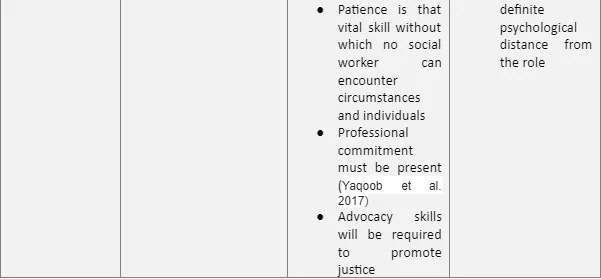
Task 3
LO 1. Understand the meaning of health promotion and health education.
1.1. Explain the significance of health promotion and health education
Health promotion term can be referred as the significant process of making people enable people to ensure that increase in the control over health and adding to this also improve their health also. The term health promotion is introduced by the World Health Organisation (WHO) Ottawa Charter for promoting health consciousness among people. On the other hand, health education is a profession that enables to educate people about their health and its requirements (Bentsen et al. 2020). Under the arena of health education, there are various aspects such as environmental health, spiritual health, reproductive and sexual health and intellectual health. Basically health education is a specific combination of all the learning experiences that are gathered and designed to help the individuals and other communities also and encourage them to improve their health by increasing their attitude and knowledge about their own and family health.
Health education and health promotion are interlinked with each other because health education is a specific measure or strategy that are implemented for health promotion so that diseases can be prevented with various types of preventing programs and strategies that are tailored targeting the population (Bentsen et al. 2020).
LO 2. Understand the approaches to health promotion/education.
2.1. Evaluate the approaches used in health promotion and health education
There are five main approaches that are used for effective utilisation of the health promotion and that are Medication which means sending and educating people about appropriate medication knowledge and information and teaching them how to attain medication in emergency situations. The second approach is behavioural change which is little tough to utilise since changing a person’s attitude and behaviour regarding any rigid and fixed perception about the health consciousness and improvement in people (Taylor et al. 2020). The third approach is educational where the key focus is to give proper education to the people regarding the matter to encourage them more. The fourth approach is client centred which says that promotional education about heath must be given according to the people and not same to all. The fifth approach is of societal change the perception of the society needs to be changed regarding the health care knowledge.
The approaches of health education mainly aim at decreasing the mortality and morbidity rate with the help of various types of preventive healthcare issue programs (Taylor et al. 2020). Informed decision making and persuasion are the two other types of health education approaches which create awareness increasing primary prevention among people.
LO 3. Understand the role health professionals in promoting health.
3.1. Compare and contrast the health education/promotion role of different health professionals in different settings
In case of different situations and settings, health education and health promotion plays two different roles such as health education and promotion in nursing field if creating awareness about the nursing job importance and health promotion is to spread knowledge regarding the duties and responsibilities of the nursing work (Yaqoob et al. 2017). As in this, the health education in mental health nursing means the spreading of knowledge about the metal health disease and how to handle mental health patients. On the other hand, health promotion in mental health condition is giving information about the mental health acre and how to manage the caring of a mental health patient. In another setting of social worker, the health education is spreading the information that how to keep health in all aspects of a good healthy person including the social health, physical health, environmental health and other attributes of a good healthy person and their well-being (Pattar et al. 2018). And health promotion in this aspect is making people motivated about being healthy and fit by different measures and making them understand the importance of good health in a person’s life. Al of these arenas are different from each other but still are connected to each them in many dimensions.
LO 4. Understand how the mass media is used promoting health.
4.1. Evaluate how the mass media is used in health promotion
The reach and power of mass media is so much powerful that it can influence all the aspects of a person’s life and can change rigid attitude and decisions also (Nghiem et al. 2018). Mass media is a very common and expertise measure to promote healthcare education and health care promotion since it is the only method which can plant encouragement among people regarding the health consciousness and well-being. As stated by OKEYA and AKINWANDE (2020), mass media in relation to health promotion can harness health and well-being to promote by informing, empowering, and motivating people to bring change in their present behaviour and also ensures that a common and effective platform can be presented to advocate better and healthier civic action, policies and activities too.

The mass media plays a very critical and crucial role in the process of disseminating the health knowledge and increase awareness related with the health education (Nghiem et al. 2018). So mass media is inter connected to both health promotion and health education at the same time it also influences the audiences for achieving a better health and well-being in all of its aspects whether mentally, emotionally, socially or environmentally.
Conclusion
The assessment above picturises an academic poster about the health promotion and health education roles on different perspective situations and presents a comparison and contrasting picture of the three different roles in different healthcare settings. Adding to this this assessment has a second part also that provides knowledge about various types of approaches that can be adopted to functions of health promotion focusing the health education which are closely related with each other. The important and usefulness of mass media shows that how it can influence and change human perspectives and behavioural traits. Lastly it can be concluded that health promotion term can be referred as the significant process of making people enable people to ensure that increase in the control over health and adding to this also improve their health also.
References
Bentsen, P., Bonde, A.H., Schneller, M.B., Danielsen, D., Bruselius-Jensen, M. and Aagaard-Hansen, J., 2020. Danish ‘add-in’school-based health promotion: integrating health in curriculum time. Health promotion international, 35(1), pp.e70-e77.
Cusack, E., Killoury, F. and Nugent, L.E., 2017. The professional psychiatric/mental health nurse: skills, competencies and supports required to adopt recovery‐orientated policy in practice. Journal of psychiatric and mental health nursing, 24(2-3), pp.93-104.
Kemp, K., Dibley, L., Chauhan, U., Greveson, K., Jäghult, S., Ashton, K., Buckton, S., Duncan, J., Hartmann, P., Ipenburg, N. and Moortgat, L., 2018. Second N-ECCO consensus statements on the European nursing roles in caring for patients with Crohn’s disease or ulcerative colitis. Journal of Crohn's and Colitis, 12(7), pp.760-776.
Nghiem, N., Cleghorn, C.L., Leung, W., Nair, N., van der Deen, F.S., Blakely, T. and Wilson, N., 2018. A national quitline service and its promotion in the mass media: modelling the health gain, health equity and cost–utility. Tobacco control, 27(4), pp.434-441.
OKEYA, A.O. and AKINWANDE, A., 2020. Mass Media Health Promotion Campaign as Determinant of Behavioural Responses to the Prevention of Lassa Fever Epidemic in South-West, Nigeria. The Nigerian Journal of Communication (TNJC), 17(2).
Pattar, S., Buyya, R., Venugopal, K.R., Iyengar, S.S. and Patnaik, L.M., 2018. Searching for the IoT resources: Fundamentals, requirements, comprehensive review, and future directions. IEEE Communications Surveys & Tutorials, 20(3), pp.2101-2132.
Perlman, D., Taylor, E., Moxham, L., Patterson, C., Brighton, R., Heffernan, T. and Sumskis, S., 2017. Innovative mental health clinical placement: developing nurses' relationship skills. Journal of psychosocial nursing and mental health services, 55(2), pp.36-43.
Taylor, J., O'Hara, L., Talbot, L. and Verrinder, G., 2020. Promoting health: the primary health care approach. Elsevier.
Wu, X.V., Chan, Y.S., Tan, K.H.S. and Wang, W., 2018. A systematic review of online learning programs for nurse preceptors. Nurse education today, 60, pp.11-22.
Yaqoob, I., Ahmed, E., Hashem, I.A.T., Ahmed, A.I.A., Gani, A., Imran, M. and Guizani, M., 2017. Internet of things architecture: Recent advances, taxonomy, requirements, and open challenges. IEEE wireless communications, 24(3), pp.10-16.
- 24/7 Customer Support
- 100% Customer Satisfaction
- No Privacy Violation
- Quick Services
- Subject Experts



